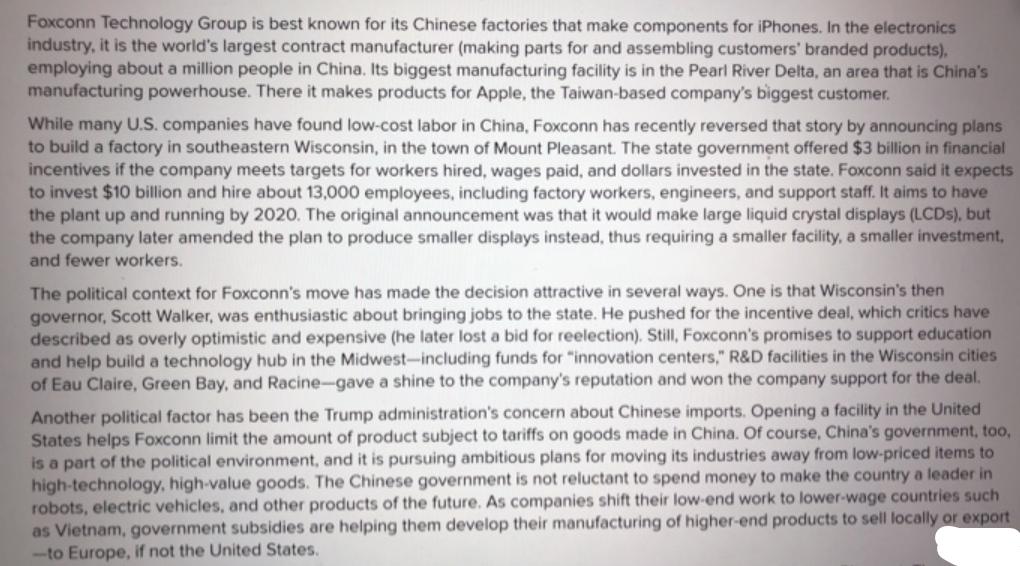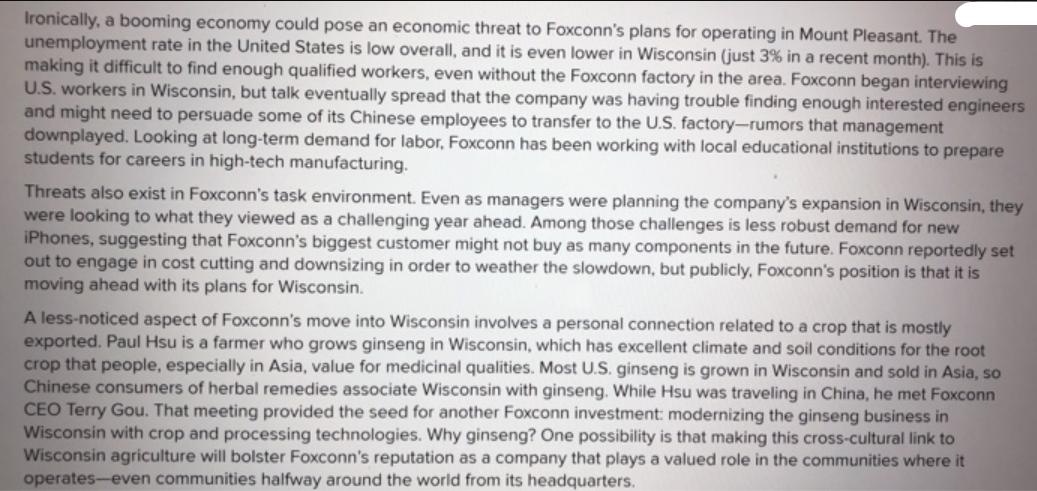Answered step by step
Verified Expert Solution
Question
1 Approved Answer
Foxconn Technology Group is best known for its Chinese factories that make components for iPhones. In the electronics industry, it is the world's largest



Foxconn Technology Group is best known for its Chinese factories that make components for iPhones. In the electronics industry, it is the world's largest contract manufacturer (making parts for and assembling customers' branded products), employing about a million people in China. Its biggest manufacturing facility is in the Pearl River Delta, an area that is China's manufacturing powerhouse. There it makes products for Apple, the Taiwan-based company's biggest customer. While many U.S. companies have found low-cost labor in China, Foxconn has recently reversed that story by announcing plans to build a factory in southeastern Wisconsin, in the town of Mount Pleasant. The state government offered $3 billion in financial incentives if the company meets targets for workers hired, wages paid, and dollars invested in the state. Foxconn said it expects to invest $10 billion and hire about 13,000 employees, including factory workers, engineers, and support staff. It aims to have the plant up and running by 2020. The original announcement was that it would make large liquid crystal displays (LCDs), but the company later amended the plan to produce smaller displays instead, thus requiring a smaller facility, a smaller investment, and fewer workers. The political context for Foxconn's move has made the decision attractive in several ways. One is that Wisconsin's then governor, Scott Walker, was enthusiastic about bringing jobs to the state. He pushed for the incentive deal, which critics have described as overly optimistic and expensive (he later lost a bid for reelection). Still, Foxconn's promises to support education and help build a technology hub in the Midwest-including funds for "innovation centers," R&D facilities in the Wisconsin cities of Eau Claire, Green Bay, and Racine-gave a shine to the company's reputation and won the company support for the deal. Another political factor has been the Trump administration's concern about Chinese imports. Opening a facility in the United States helps Foxconn limit the amount of product subject to tariffs on goods made in China. Of course, China's government, too, is a part f the political environment, and it is pursuing ambitious plans for moving its industries away from low-priced items to high-technology, high-value goods. The Chinese government is not reluctant to spend money to make the country a leader in robots, electric vehicles, and other products of the future. As companies shift their low-end work to lower-wage countries such as Vietnam, government subsidies are helping them develop their manufacturing of higher-end products to sell locally or export -to Europe, if not the United States. Ironically, a booming economy could pose an economic threat to Foxconn's plans for operating in Mount Pleasant. The unemployment rate in the United States is low overall, and it is even lower in Wisconsin (just 3% in a recent month). This is making it difficult to find enough qualified workers, even without the Foxconn factory in the area. Foxconn began interviewing U.S. workers in Wisconsin, but talk eventually spread that the company was having trouble finding enough interested engineers and might need to persuade some of its Chinese employees to transfer to the U.S. factory-rumors that management downplayed. Looking at long-term demand for labor, Foxconn has been working with local educational institutions to prepare students for careers in high-tech manufacturing. Threats also exist in Foxconn's task environment. Even as managers were planning the company's expansion in Wisconsin, they were looking to what they viewed as a challenging year ahead. Among those challenges is less robust demand for new iPhones, suggesting that Foxconn's biggest customer might not buy as many components in the future. Foxconn reportedly set out to engage in cost cutting and downsizing in order to weather the slowdown, but publicly, Foxconn's position is that it is moving ahead with its plans for Wisconsin. A less-noticed aspect of Foxconn's move into Wisconsin involves a personal connection related to a crop that is mostly exported. Paul Hsu is a farmer who grows ginseng in Wisconsin, which has excellent climate and soil conditions for the root crop that people, especially in Asia, value for medicinal qualities. Most U.S. ginseng is grown in Wisconsin and sold in Asia, so Chinese consumers of herbal remedies associate Wisconsin with ginseng. While Hsu was traveling in China, he met Foxconn CEO Terry Gou. That meeting provided the seed for another Foxconn investment: modernizing the ginseng business in Wisconsin with crop and processing technologies. Why ginseng? One possibility is that making this cross-cultural link to Wisconsin agriculture will bolster Foxconn's reputation as a company that plays a valued role in the communities where it operates-even communities halfway around the world from its headquarters. Questions for Discussion 1. What forces does this case describe operating in Foxconn's global environment? 2. In light of the threats and opportunities described in this case, do you think Foxconn's plans to open a facility in Wisconsin will help it compete? Why or why not? 3. The trend toward globalization gave Foxconn a major business opportunity to be a supplier of technology, especially to Apple. To the extent that political forces have recently led to tariffs and other barriers to trade, what impact on Foxconn would you expect to see (or have you seen)?
Step by Step Solution
There are 3 Steps involved in it
Step: 1
1 The case describes several forces operating in Foxconns global environment 1 Labor Cost and Availability Foxconn initially established itself as a major contract manufacturer in China taking advanta...
Get Instant Access to Expert-Tailored Solutions
See step-by-step solutions with expert insights and AI powered tools for academic success
Step: 2

Step: 3

Ace Your Homework with AI
Get the answers you need in no time with our AI-driven, step-by-step assistance
Get Started


